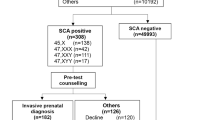Abstract
Noninvasive prenatal testing utilizing free fetal DNA is commonly used in pregnancy to screen for trisomy 13, 18, 21 and also fetal sex aneuploidy. We report on two cases of discrepancy between phenotypic and genotypic sex and potential medical implications. In our first case, a patient with known male gender via cell free fetal DNA (cffDNA) testing had an ultrasound at 18 weeks’ gestation, which identified Dandy–Walker malformation and female-appearing ambiguous genitalia. As Dandy–Walker malformation could not be considered isolated in the presence of ambiguous genitalia, this finding allowed for more complete counseling of the parents as well as extensive genetic workup. Our second case involved a fetus with intrauterine growth restriction diagnosed by ultrasound and normal-appearing female genitalia. After birth, adrenal insufficiency was diagnosed and chromosome analysis identified normal male chromosomes. These two cases showed that fetal sex determination by cffDNA can be used as a tool for earlier identification of affected pregnancies, allowing for parental decision-making, genetic testing and earlier intervention.
This is a preview of subscription content, access via your institution
Access options
Subscribe to this journal
Receive 12 print issues and online access
$259.00 per year
only $21.58 per issue
Buy this article
- Purchase on Springer Link
- Instant access to full article PDF
Prices may be subject to local taxes which are calculated during checkout
Similar content being viewed by others
References
Swanson A, Sehnert AJ, Bhatt S . Non-invasive prenatal testing: technologies, clinical assays and implementation strategies for women's healthcare practitioners. Curr Genet Med Rep 2013; 1 (2): 113–121.
Benn P, Cuckle H, Pergament E . Non-invasive prenatal testing for aneuploidy: current status and future prospects. Ultrasound Obstet Gynecol 2013; 42 (1): 15–33.
Mazloom AR, Džakula Ž, Oeth P, Wang H, Jensen T, Tynan J et al. Noninvasive prenatal detection of sex chromosomal aneuploidies by sequencing circulating cell-free DNA from maternal plasma. Prenat Diagn 2013; 33 (6): 591–597.
Hill M, Barrett AN, White H, Chitty LS . Uses of cell free fetal DNA in maternal circulation. Best Pract Res Clin Obstet Gynaecol 2012; 26 (5): 639–654.
Gil MM, Quezada MS, Bregant B, Ferraro M, Nicolaides KH . Implementation of maternal blood cell-free DNA testing in early screening for aneuploidies. Ultrasound Obstet Gynecol 2013; 42 (1): 34–40.
Devaney SA, Palomaki GE, Scott JA, Bianchi DW . Noninvasive fetal sex determination using cell-free fetal DNA: a systematic review and meta-analysis. JAMA 2011; 306 (6): 627–636.
Wright CF, Wei Y, Higgins JP, Sagoo GS . Non-invasive prenatal diagnostic test accuracy for fetal sex using cell-free DNA a review and meta-analysis. BMC Res Notes 2012; 5: 476.
Torres B, Stoffel TJ, Oro D, Rossi EM, de Miranda GB, Houenou LJ et al. Early non-invasive fetal RHD genotyping and sex determination by conventional and multiplex PCR performing a rapid and low-cost cell-free fetal DNA extraction method. Eur J Obstet Gynecol Reprod Biol 2012; 165 (2): 370.
Lewis C, Hill M, Skirton H, Chitty LS . Fetal sex determination using cell-free fetal DNA: service users' experiences of and preferences for service delivery. Prenat Diagn 2012; 32 (8): 735–741.
Chitty LS, Chatelain P, Wolffenbuttel KP, Aigrain Y . Prenatal management of disorders of sex development. J Pediatr Urol 2012; 8 (6): 576–584.
Devaney SA, Palomaki GE, Scott JA, Bianchi DW . Noninvasive fetal sex determination using cell-free fetal DNA: a systematic review and meta-analysis. JAMA 2011; 306: 627–636.
Hill M, Taffinder S, Chitty LS, Morris S . Incremental cost of non-invasive prenatal diagnosis versus invasive prenatal diagnosis of fetal sex in England. Prenat Diagn 2011; 31: 267–273.
Daley R, Hill M, Chitty LS . Non-invasive prenatal diagnosis: progress and potential. Arch Dis Child Fetal Neonatal Ed 2014; 99: F426–F430.
Author information
Authors and Affiliations
Corresponding author
Ethics declarations
Competing interests
The authors declare no conflict of interest.
Rights and permissions
About this article
Cite this article
Iruretagoyena, J., Grady, M. & Shah, D. Discrepancy in fetal sex assignment between cell free fetal DNA and ultrasound. J Perinatol 35, 229–230 (2015). https://doi.org/10.1038/jp.2014.231
Received:
Accepted:
Published:
Issue Date:
DOI: https://doi.org/10.1038/jp.2014.231
This article is cited by
-
Chromosome Y as a marker for sex discrepancies in patients with organ transplants: a case report
Molecular Cytogenetics (2021)
-
Discordant sex between fetal screening and postnatal phenotype requires evaluation
Journal of Perinatology (2019)



